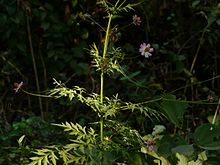Cosmos caudatus
| Cosmos caudatus | |
|---|---|

| |
| Wild Cosmos caudatus | |
| Scientific classification | |
| Kingdom: | Plantae |
| Clade: | Tracheophytes |
| Clade: | Angiosperms |
| Clade: | Eudicots |
| Clade: | Asterids |
| Order: | Asterales |
| Family: | Asteraceae |
| Genus: | Cosmos |
| Species: | C. caudatus
|
| Binomial name | |
| Cosmos caudatus | |
| Synonyms[1] | |
| |

Cosmos caudatus or king's salad is an annual plant in the genus Cosmos, bearing purple, pink, or white ray florets. It is native to Latin America (from Rio Grande do Sul in southern Brazil to Tamaulipas in northeastern Mexico),[3] and the West Indies, though naturalized in tropical parts of Asia, Africa, and Australia.[4][5][6][7][8][9]
Description[edit]
The plant is known by several vernacular names in Central America which include:[10]
- chactsul (Yucatán, Quintana Roo)
- estrella del mar (Yucatán, Quintana Roo)
- cambray (Honduras, El Salvador)
- cambray rojo (Honduras, El Salvador)
- mozote-doradilla (El Salvador)
- flor de muerto (Costa Rica)
The species grows up to 2 m (6 ft 7 in) in height. The leaves are soft and pungent while the stem is light green with a purplish hue and succulent. As night falls the leaves fold to close the terminal buds as the plant literally sleeps. The flowers can be found solitary or in a loose clusters and are produced on a single stalk on auxiliary heads.[11]
Gastronomy[edit]
Cosmos caudatus is edible and its common names include kenikir (Indonesia) or ulam raja (in Malaysia, calqued as "the King's salad").[12] In Indonesian cuisine and Malaysian cuisine the leaves of this plant are used for salad. In Brunei, it was usually served with sambal (chilli paste) together with the local cuisine, ambuyat. It was brought by the Spaniards from Latin America, via the Philippines, to the rest of Southeast Asia.[12] Ulam, a Malay word used to describe a preparation that combines food, medicine, and beauty, is a widely popular Malay herbal salad that is served throughout the country from major hotels for tourists to buffet lunches or dinners for the locals.
References[edit]
- ^ Flann C, ed. (2009). "Global Compositae Checklist". Archived from the original on 2014-11-15.
- ^ illustration circa 1880 from Francisco Manuel Blanco (O.S.A.) - Flora de Filipinas [...] Gran edicion
- ^ Melchert TE (1990). "Cosmos caudatus (Asteraceae: Coreopsideae) in Mexico: a cytotaxonomic reappraisal". Phytologia. 69 (3). USA: 200–215. doi:10.5962/bhl.part.17999. description, discussion, photographs, line drawings, distribution map
- ^ Funk VA, Berry P, Alexander S, Hollowell TH, Kelloff CL, eds. (July 2007). "Checklist of the plants of the Guiana Shield (Venezuela: Amazonas, Bolivar, Delta Amacuro; Guyana, Surinam, French Guiana)". United States National Herbarium. 55. Washington, DC: National Museum of Natural History: 1–584. CiteSeerX 10.1.1.454.3269.
- ^ Jørgensen PM, León-YánezS, eds. (1999). "Cat. Vasc. Pl. Ecuador". Monographs in Systematic Botany from the Missouri Botanical Garden. 75: i–viii, 1–1181.
- ^ Humbert H (1923). "Les Composées de Madagascar". Mémoires de la Société Linnéenne de Normandie. 25: 1–335.
- ^ Sousa Sánchez M, Cabrera Cano EF (1983). "Flora de Quintana Roo". Listados Florísticos de México. 2: 1–100.
- ^ López Vargas A (1995). Estudio de Vegetación de las Partes Sud y Sudoeste de las Provincias Mizque y Campero --- Cochabamba (Ph.D thesis). Universidad Mayor de San Simón, Cochabamba. pp. i–vi, 1–152.
- ^ Foster RC (1958). "A catalogue of the ferns and flowering plants of Bolivia". Gray Herbarium of Harvard University. 184: 1–223.
- ^ Pruski, John Francis; Robinson, Harold Ernest (2018). "Asteraceae". Flora Mesoamericana. Vol. 5. St. Louis, Missouri: Missouri Botanical Garden. pp. i–xix, 1–608.
- ^ Hassan WE (2006). Healing Herbs of Malaysia. Kuala Lumpur: Federal Land Development Agency. ISBN 978-983-99544-2-5.
- ^ a b Bodeker G (2009). Health and Beauty from the Rainforest: Malaysian Traditions of Ramuan. Kuala Lumpur: Didier Millet. ISBN 978-981-4217-91-0.
 Media related to Cosmos caudatus at Wikimedia Commons
Media related to Cosmos caudatus at Wikimedia Commons
